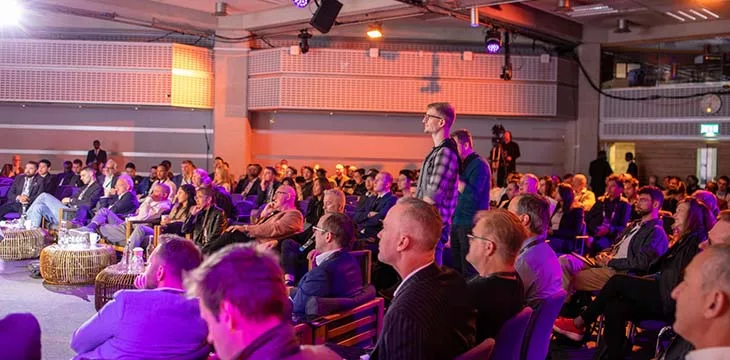E. Smitty on CoinGeek Weekly Livestream: How blockchain could usher in music revolution
width=”560″ height=”315″ frameborder=”0″ allowfullscreen=”allowfullscreen”>
Kurt Wuckert Jr. spoke with music producer and engineer E. Smitty about creating a music distribution platform on the BSV blockchain. The two talked about NFTs, the state of the music industry today, and how blockchain technology could usher in a much-needed revolution in music.
Bitcade at the South Florida Bitcoin Citadel
Wuckert begins by announcing that a Bitcade will take place at the South Florida Bitcoin Citadel on February 16 at 18.00 Everyone can turn up and play BSV-powered video games. There will be free food, drinks and some cool people to hang out with.
Join us Thursday night for a blockchain powered arcade with games from @hastearcade.
Food and drinks are served.
RSVP: pic.twitter.com/o9VX7iSC8i
— Florida Bitcoin Citadel (@Bitcoin_Florida) 13 February 2023
Introducing E. Smitty and his journey into blockchain
E. Smitty is a multi-platinum producer and engineer. He has been working in music for 22 years with some huge records. He began his career on the road, selling around 150,000 records out of the trunk of his car, and went on to find great success using various platforms such as MySpace and Twitter.
MikeDaGreatt and E. Smitty Take Hip-Hop to “Blockchain”
— 24Hip-Hop (@24HipHop__) 18 January 2023
How did he get into blockchain and digital currencies? He says he kept seeing ads for eToro in 2018 and started trying to trade daily (unsuccessfully). He became interested in the ledgers underlying these symbols and began trying them out. After getting into Hbar, XRP and Algorand, he had an idea to patent technology related to traditional music distribution via tokenization.
Builds on the BSV blockchain
Smitty soon realized that few of these tokens are tied to any kind of utility. After getting to know Christen Ager-Hanssen better, he collaborated with him and builds his project, Distro Mint, on the BSV blockchain. It is a combined NFT minting and music distribution platform, giving artists the best of both worlds, allowing them to share royalties, receive instant payments and more.
Builds something very special $BSV @nChainGlobal MVP Site will launch at the end of this month, will support multi cryptocurrencies including $HBAR $LCX $XRP $XLM…. Excited To Tokenize The Music Industry!!! pic.twitter.com/zghDfGM7sN
— E. Smitty Tokenizing The Music Industry!!! (@THEREALESMITTY) 7 February 2023
Why BSV? In addition to his friendship with Ager-Hanssen, Smitty began to research and realize BSV’s technological superiority, and he fell in love with the ecosystem’s attitude. It’s focused on creating value rather than extracting it, which appeals to him.
Speaking more about his partnership with Christen Ager-Hanssen, Smitty says the platform they’re building will be bigger and better than OpenSea. He acknowledges that right now OpenSea is the biggest and best NFT platform, but this will get better. They aim to launch phase one at the end of the month, and more phases will happen as new features are built. Smitty already has some famous hip-hop artists, rock stars and jazz musicians lined up to get involved.
“I found my home in BSV,” says Smitty, emphasizing that he has many projects in mind and will build them one by one.
Questions and answers
Viewers have some questions for Smitty, and Wuckert invites them to ask them at this stage of the podcast.
Questions. When you say distribution, do you mean streaming or selling records as NFTs?
Smitty says he means traditional music distribution, including sites that offer streaming as well as selling music via downloads. Through an agreement with Orchard Sony, this includes playing music via kiosks in bars and more. Eventually, Smitty wants to take the entire traditional music distribution infrastructure and put it on the blockchain.
Q. What can we do to bring back good music and disrupt the business model?
Wuckert notes that the quality of the music has declined recently. He also singles out artists who became stars who die penniless because the business model in the industry is tilted in favor of the record companies. He wants to know what can be done to remedy both of these things.
Smitty says that it is not necessarily the companies that deal with the artists, but that there are far too many of them. He believes that platforms such as Spotify should show artists. NFTs will change this for the better – people will go back to only paying for what they feel is valuable rather than lumping everything together in the subscription model. He also believes that real music is making a comeback, and the quality is improving. He is optimistic about the future of the music industry.
Q. You both mentioned “analog” music. What does that mean?
Smitty explains that all music is still made and recorded through an analogue process. Your voice travels through circuits, pipes, wires and into a device. Using a baking analogy, he says you combine and mix it, and the icing on the cake is the mastering process. On the other hand, digital music is a computer emulation of this process. Smitty uses both, but he prefers analog for the tone, depth and feel of the music.
Q. What does the process of using Distro Mint look like for an artist?
Smitty explains that the onboarding process will be super easy. You will log in with HandCash, add a social media account and create an artist profile. From there, you can start creating and distributing music immediately. This will require entering some information and selecting a package. There will be different packages for different needs, including indie labels with huge catalogs, individual artists with one album and more.
See: Music and blockchain
width=”560″ height=”315″ frameborder=”0″ allowfullscreen=”allowfullscreen”>
New to Bitcoin? Check out CoinGeeks Bitcoin for beginners section, the ultimate resource guide for learning more about Bitcoin – as originally envisioned by Satoshi Nakamoto – and blockchain.


